
|   |

|   |
Garland of Memories: Celebrating the life and times of a legendary Guru - Kiran Java e-mail: kiran@kiranjava.com July 11, 2021 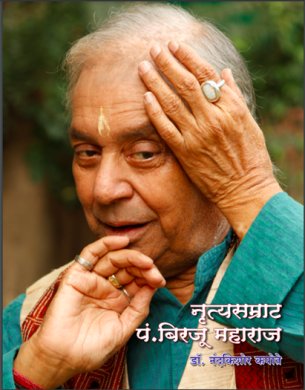 Nritya Samrat Pt. Birju Maharaj by Dr. Nandkishore Kapote nkapote9@gmail.com Published: June 2021 Message/Greeting by Dr. Sonal Mansingh and Dr. Padma Subrahmanyam Cover Photo by Avinash Pasricha, Back Cover Photo by Innee Singh Back Cover Poetry by Pt. Birju Maharaj Language: Bi-lingual (Hindi | English) Pages: 368 Size: 7" x 9" ISBN 978-93-5473-457-1 This book was inaugurated by Pt. Birju Maharaj in Delhi and was released at Pune Patrakar Bhavan on June 29, 2021, at a felicitation held for Kathak exponents. Dr. Nandkishore Kapote is a senior Kathak exponent and Artistic Director of Nandkishore Cultural Society. He is the recipient of the Maharashtra State Dr. Babasaheb Ambedkar Dalit Mitra Award 2010 and the Maharashtra State Cultural Award 2004 amongst others. It is at his academy in Nigdi where Pt. Birju Maharaj has spent his days whenever he visits Pune since the late 1970s. Dr. Kapote studied from Pt. Birju Maharaj at Kathak Kendra Delhi, under a National Scholarship programme from the Cultural Department, and thus they are bound by a 40-year Guru-Shishya relationship. Having witnessed firsthand his teaching methodology, accompanied him on numerous tours, and had countless opportunities to discuss dance even after returning to Maharastra, Dr. Kapote has the required vision and insight to write about his Guru. So it was not a surprise that he would contemplate a project of collating his memories with his Guru. However, what is commendable is that he chose to share his stage of memories with myriad artists, scholars, peers, associates, and disciples of Pt. Birju Maharaj, encouraging them to pen their stories and add them to this exclusive collection of essays. This is the first time such a collection has been released. Nritya Samrat Pt. Birju Maharaj, begins with messages by Dr. Sonal Mansingh and Dr. Padma Subrahmanyam, both legends in their respective fields of dance. They have not only shared space with Pt. Birju Maharaj, both on and off stage, but also share a great camaraderie. This is followed by a foreword by Shobha Rasik Sheth Dhariwal, who took on the mammoth task of printing this book. At the felicitation function, she shared that she was inspired by Pt. Birju Maharaj's words that "Service (Sewa) of Kala (art) should be performed in the same manner as one performs service towards Ishwar (God)." In the section titled 'Bhoomika' written by Dr. Kapote, he highlights his vision as well as what the reader can expect from the book. The book has a total of ninety-two essays on Pt. Birju Maharaj, written by legendary artists, celebrated Kathak exponents from all four 'Gharanas', associates, and well-wishers from all over the world. He makes the reader aware that most contributors are not writers, yet they have come forward to share their stories as a tribute to a legend. The writings bring to life the interactions of a guru and his disciples over six decades. They speak of each contributor's reverence for their guru whilst the candid stories leave one spellbound. A recommended read to know about the journey of the artists and to understand the persona of Pt. Birju Maharaj, be it Kathak dance technique, the ethos of the 'guru-shishya' tradition, humility, being simple, being wise, emphasizing spirituality, upholding an iconic legacy, learning and teaching the art form. The book is a definite contribution to the field of Kathak. Later in the book is a detailed essay by Dr. Nandkishore Kapote which reads like an encyclopedia on Pt. Birju Maharaj. In his essay, the reader will also find a list of books authored by Pt. Birju Maharaj, a list of books written about Birju Maharaj, a list of movies with his choreographies, the entire list of ballets produced by Pt. Birju Maharaj, modern choreographies, a list of awards presented to him, etc. - all in one place. 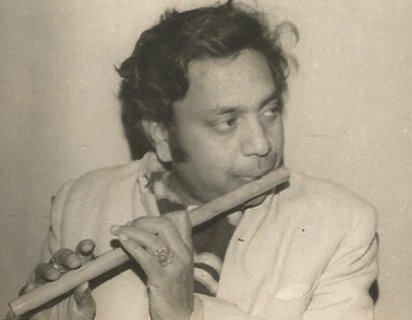 Photo: Innee Singh ; Courtesy: Nandkishore Cultural Society Archives 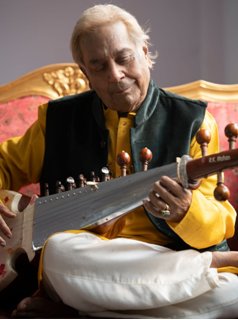 Photo: Innee Singh If the life and times of a legendary guru can be distilled into a book, then Nritya Samrat Pt. Birju Maharaj certainly does justice to the shades of Pt. Birju Maharaj's persona. The writings of some very senior artists of the Kathak field transports the reader into a different era of learning and performing Kathak. When great artists such as the senior Dagar brothers, Ustad Mushtaq Hussain Khan, Ustad Hafez Ali Khan, Pt. Purshottam Das, etc. used to frequent Birju Maharaj's classes. When the first ballets were being created and performed. The reader will find a rather consistent portrait of a man who shaped the history of Kathak. 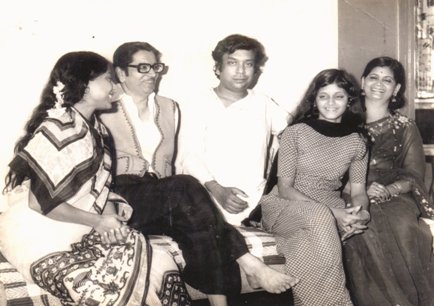
In 1979, Pt. Birju Maharaj visited Vimal and Bhaskar Kapote, the parents
of Dr. Kapote in Pune for the first time. Birju Maharaj surprised
them by singing the Marathi song 'Jaiche Asel Jari Nakalta Nighun Ja'
Extraordinary performer Through various essays, the book gives us insights into Pt. Birju Maharaj's mastery over his form. Manjari Sinha, senior art critic and musicologist, rightly points out his engagement with his creation and the power of his presentations. In Shama Bhate's view, the 'Mayur Gat' became famous after Birju Maharaj's unique presentation. "It is said that sometimes an artistic depiction often seems more effective than reality and this has been the case with Birju Maharaj's depiction of the peacock," she writes. Suresh Talwalkar, eminent tabla player writes that just through the mere gaze of his eyes or flick of a hand movement, Pt. Birju Maharaj can bring meaning to an entire bandish composition. 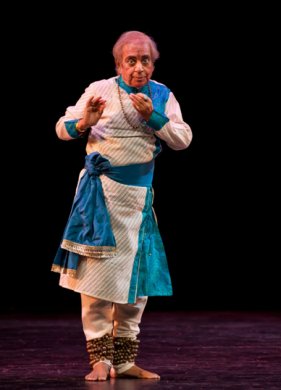 A Guru's caring nature Pt. Birju Maharaj's concern for his students' welfare wherever they are in the world can be seen in many of the writings. A few years ago, I witnessed a performance in Dubai by one of Maharaj's disciples who had been through an accident and had stopped dancing for many years. Maharaj had motivated her to keep up with her singing so that she could still be connected to the arts. Finally, when she returned to dance five years ago, Birju Maharaj was overjoyed and he not only came himself to attend her performance but also performed on stage! He and Saswati Sen held workshops to launch her academy. In the book, the same sentiment can be seen in the essay by Manjusree Chatterjee when in 1986 she suddenly lost her husband and then a fall had left her paralysed from her waist down to her feet. She writes that he would tell her that as a 'kalakaar', she can rise again. "I can never forget the way Maharaj Ji helped me come out of that phase. I was able to not only walk but also dance again," she shares. In Sadhana Rajendra Kapote's essay, we see a glimpse of how Maharaj's humble nature has attracted even the general public and made them his fans forever. His teaching style and ethics The book reveals the extraordinary nature of Pt. Birju Maharaj's teaching style and ethics spanning over six decades. In her article, Saswati Sen, Birju Maharaj's prime disciple, has enumerated three salient features of Kathak expounded by him. 'The Kathak workshop - A bouquet of experiences' written by Sunil Sunkara throws light upon why Birju Maharaj furthered this concept of teaching. Janaki Patrik's article is filled with insights into Birju Maharaj's teaching of 'abhinaya'. Dr. Kapote has mentioned how Birju Maharaj has made the technique of taking the classic Lucknow Gharana 'chakkar' spin so easy to learn. From the pages of his class journal that he used to keep during his Kathak Kendra days, Dr. Kapote generously shares the sequence of performance as envisioned by Birju Maharaj. Dr. Shovana Narayan and others have expounded upon the beautiful Guru-Shishya tradition. 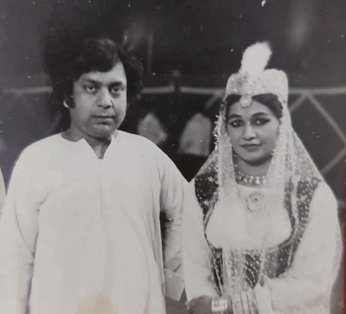 A great visionary Diverse facets of Pt. Birju Maharaj's vision is apparent from the various essays. Dr. Navina Jafa shares how Birju Maharaj had an idea to make special 'ghungroos' to the tone of different musical notes and then created a visualization of the pentatonic scale raga Bhupali through choreography. Mamta Maharaj, the first female dancer from the 'Kalka-Bindadin' family writes that Pt. Birju Maharaj created such productions that have enabled the female Kathak practitioner to receive recognition at the same level as her male counterpart. The article 'Aesthetic beauty of Birju Maharaj Ji's cinematic choreography', written by Paullumi Mukheerjee, shares Pt. Birju Maharaj's vision of Kathak in films. The book also includes some rare colour and black & white photographs of Pt. Birju Maharaj playing various musical instruments including sarod and flute, creating a painting on a canvas, dressed in the traditional Maharashtrian dress and Arabian head-dress (complete with Agal and Ghutrah). Pictures of Birju Maharaj's paintings are also included. 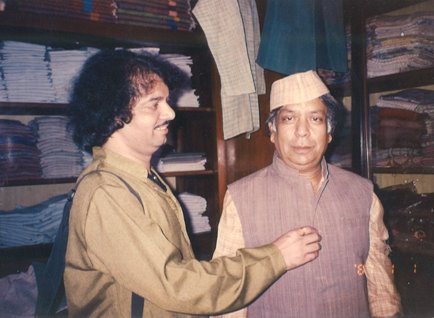 Photo courtesy: Nandkishore Cultural Society Archives Essays included in the book are by celebrated national and international artists, a list that reads like a who's who of the performing arts world. Essays in the Hindi language are contributed by Krishan Mohan Maharaj, Ram Mohan Maharaj, Kavita Mishra, Jaikishan Maharaj, Anita Maharaj Kulkarni, Mamta Maharaj, Deepak Maharaj, Ipshita Mishra, Vaswati Mishra, Archana Maharaj, Swaransh Mishra, Tribhuvan Maharaj, Ramlal Bareth, Pratap Pawar, Dr. Uma Sharma, Prabha Marathe, Dr. Padma Sharma, Dr. Purnima Pande, Saswati Sen, Manjari Sinha, Chetna Jalan, Suresh Talwarkar, Kumar Bose, Dr. Ajay Pohankar, Ulhasdada Pawar, Bipul Das, Dr. Nandkishore Kapote, Sharadini Gole, Dr. Sujata Natu, Shama Bhate, Maneesha Sathe, Dr. Manjiri Deo, Jayanti Mala Mishra, Dr. Shailesh Srivastav, Dr. Shubhangi Arun Bahulikar, Bharat Jangam, Neelima Adhye, Sanjeevani Kulkarni, Rekha Nadgoda, Kiran Bhargav, Renu Sharma, Kajal Sharma, Jaishree Jangam, Urmila Sharma, Shubha Desai, Purnima Khadga, Madhuri Joshi, Shekhar Kumbhojkar, Yogini Gandhi, Mani Kumar Thapa, Madan Solanki, Kalinath Mishra, Umesh Moghe, Arvind Kumar Azad, Mukund Raj Deo, Vidya Hari Deshpande, Ashwani Chopra, Dr. Chitra Sharma, Meena Shete-Sambhu, Harshvardhan Singh, Aryav Anand, Shivji Mishra, Meena Chandrakanth Gokhale, Kapote Family including Sadhana Rajendra Kapote, Rajendra Kapote, Tanvi Kapote, Suraj Kapote, Chandrashekhar Kapote, Nikita Kapote-Singh and Aniket Kapote. Essays in the English language are by Shinjini Kulkarni, Ragini Maharaj, Manjusree Chatterjee, Janaki Patrik, Dr. Shovana Narayan, Geetanjali Lal, Late Dr. Sunil Kothari, Brojan Mukharjee, Janhavi Dhariwal, Mira Pundol, Raghav Raj Bhatt, Kiran Chouhan, Dr. Navina Jafa, Sharmila Sharma, Anuradha Nag, Shila Mehta, Madhavi Jhala, Sandip Mallick, Paullumi B. Mukheerjee, Sunil Sunkara, Nahid Siddiqui and Moli Siddharth. The book paper quality is excellent and has a hardback binding of a superior standard. The back cover has a poem written by Pt. Birju Maharaj. The book is sure to appeal to artists and a wide spectrum of readers. 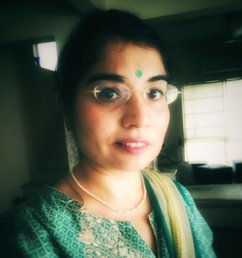 Kiran Java has over 20 years of experience in PR in the Middle East, writing for a range of publications since 2003. Kiran has done her Diploma in Natyashastra with Kathak relevancy under Dr. Puru Dadheech at Bharata College. She is also the curator-editor at Pushtimarg Studies. She holds a Bachelor of Science in Marketing from Eastern Connecticut State University, USA, and is currently reading for a Masters in Journalism and Communication. Post your comment Please provide your name and email id when you use the Anonymous / blog profile to post a comment. All appropriate comments posted in the blog will also be featured in the site. |